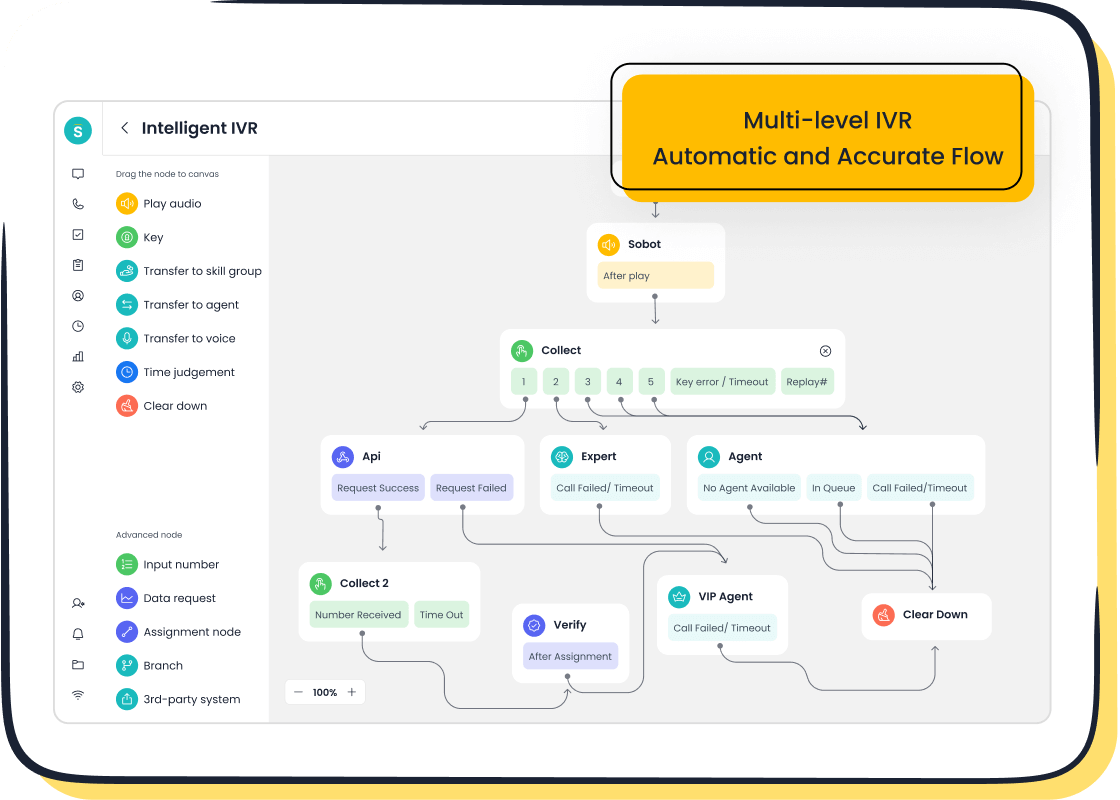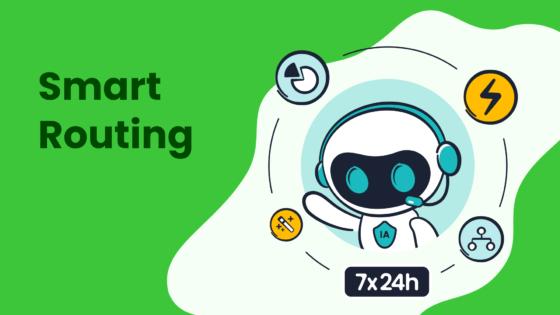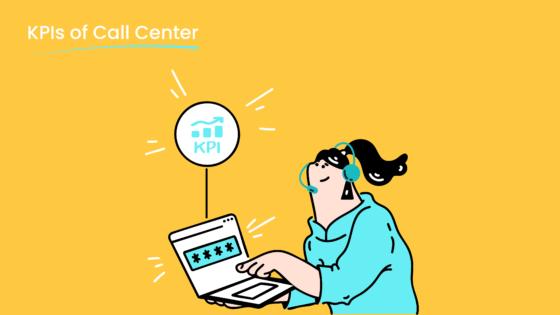What is Average Delay to Abandon ADA
Average Delay to Abandon (ADA) measures how long customers wait in a queue before giving up on a call. This metric reflects customer patience and directly impacts satisfaction. For instance, most customers abandon calls after waiting 2 minutes and 36 seconds. In industries like customer support, keeping wait times under 2 minutes is crucial to maintaining satisfaction. ADA also helps you evaluate the efficiency of your contact center operations.

Understanding ADA is essential for improving customer experiences. Tools like Sobot's Voice/Call Center can help you monitor and reduce ADA, ensuring better queue management and operational success.
Why Average Delay to Abandon (ADA) Matters
Impact on Customer Satisfaction
How long wait times frustrate customers
Long wait times often lead to customer frustration. Studies show that approximately 34% of customers abandon calls due to delayed responses and never call back. This behavior highlights the importance of managing wait times effectively. For instance, in the healthcare industry, the Average Speed to Answer (ASA) benchmark is 3 minutes and 22 seconds, far exceeding the standard of 28 seconds. Patients often abandon calls within a minute, with 60% doing so, which negatively impacts satisfaction. By reducing the average delay to abandon, you can prevent such frustrations and improve customer experiences.
The link between ADA and customer loyalty
A high average delay to abandon directly affects customer loyalty. When customers face long wait times, they may perceive your service as inefficient, leading to dissatisfaction. Maintaining a low call abandonment rate is crucial for retaining customers. Strategies like offering callback options or providing estimated wait times can help reduce ADA. These measures not only enhance satisfaction but also foster trust and loyalty, ensuring long-term customer relationships.
Operational Efficiency in Contact Centers
ADA as a measure of staffing and resource allocation

The average delay to abandon serves as a critical indicator of staffing efficiency. High ADA often signals understaffing or poor resource allocation. By tracking this metric, you can adjust staffing levels to meet demand, especially during peak hours. For example, Sobot's Voice/Call Center offers real-time analytics to help you monitor ADA and optimize workforce management. This ensures that your contact center operates efficiently, reducing costs and improving service quality.
How ADA reflects overall queue management effectiveness

ADA also reflects the effectiveness of your queue management strategies. A high ADA suggests inefficiencies in call routing or prioritization. Tools like Sobot's intelligent IVR and smart call routing can streamline these processes, ensuring that calls are handled promptly. Effective queue management not only lowers ADA but also enhances the overall customer experience, setting your contact center apart from competitors.
ADA as a Key Performance Indicator (KPI)
Why ADA is a standard metric in customer service
ADA is a standard metric because it provides valuable insights into customer patience and service efficiency. It helps you understand how long customers are willing to wait before abandoning a call. This metric is particularly important in industries where quick responses are critical, such as healthcare and financial services. Monitoring ADA allows you to identify areas for improvement and implement strategies to enhance service quality.
Comparing ADA with other call center metrics
While metrics like Average Handle Time (AHT) and First Call Resolution (FCR) are important, ADA offers unique insights into customer behavior. For example, a low ADA indicates that your contact center is meeting customer expectations for wait times. In contrast, a high ADA may signal issues that require immediate attention. By comparing ADA with other metrics, you can gain a comprehensive understanding of your contact center's performance and make data-driven decisions.
How is Average Delay to Abandon (ADA) Calculated?
The Formula for ADA
Explanation of the ADA formula: Total wait time of abandoned calls ÷ Number of abandoned calls
To calculate the average delay to abandon (ADA), divide the total wait time of all abandoned calls by the number of calls that were abandoned. This formula provides a clear measure of how long customers typically wait before giving up. For example, if 50 calls were abandoned in a day, and their combined wait time was 250 minutes, the ADA would be 5 minutes. This metric helps you identify inefficiencies in your queue management and staffing.
Example calculation for clarity
Let’s break it down further with a table:
| Metric | Value |
|---|---|
| Total Wait Time (minutes) | 250 |
| Number of Abandoned Calls | 50 |
| ADA (minutes) | 5 |
This simple calculation highlights how ADA can pinpoint areas needing improvement, such as peak hours when abandonment rates spike.
Data Sources for Measuring ADA
Call center software and analytics tools
Accurate ADA measurement relies on robust data collection. Call center software like Sobot's Voice/Call Center provides detailed reports, including metrics like average wait time, queue activity, and call abandonment rates. These tools offer real-time analytics, enabling you to monitor ADA and make adjustments as needed. For example, Queue Activity Reports track average queue times and agent response rates, offering insights into operational efficiency.
Importance of accurate data collection
Reliable data is essential for calculating ADA. Incomplete or inaccurate data skews results, leading to poor decision-making. Tools like Sobot's Call Detail Reports (CDR) ensure comprehensive data collection, capturing caller ID, hold times, and call durations. A travel agency, for instance, used CDR to identify routing errors, reducing call transfers and improving first-call resolution rates.
Common Challenges in Calculating ADA
Handling incomplete or inaccurate data
Incomplete data can distort ADA calculations. Missing records of abandoned calls or incorrect timestamps create inaccuracies. To address this, use software that integrates seamlessly with your systems, like Sobot's Voice/Call Center. Its real-time monitoring ensures data accuracy, helping you maintain reliable ADA metrics.
Differentiating between abandoned and completed calls
Distinguishing abandoned calls from completed ones can be tricky, especially when calls drop due to technical issues. Advanced analytics tools simplify this process by categorizing calls based on their outcomes. For example, Sobot's Queue Activity Reports provide detailed breakdowns, ensuring accurate identification of abandoned calls.
Factors Influencing Average Delay to Abandon (ADA)
Queue Length and Call Volume
How high call volumes increase ADA

High call volumes significantly impact the average delay to abandon. When too many customers call simultaneously, queues become longer, and wait times increase. This often leads to higher abandonment rates. For example, approximately 34% of customers hang up due to delayed responses, highlighting the direct relationship between call volume and customer retention. Real-time insights into queue lengths can help you identify bottlenecks and adjust resources accordingly. Tools like Sobot's Voice/Call Center provide these insights, enabling you to manage call volumes effectively and reduce the average delay.
The role of peak hours in ADA fluctuations
Peak hours create additional challenges for managing ADA. During these times, call volumes surge, leading to longer queues and higher abandonment rates. For instance, industries like retail and financial services often experience peak call times during lunch hours or seasonal sales. Monitoring these fluctuations allows you to allocate resources more effectively. Sobot's real-time analytics can help you track queue activity and adjust staffing levels to maintain service quality during peak periods.
Staffing and Resource Allocation
Understaffing and its impact on ADA
Understaffing is a major factor contributing to a high average delay to abandon. When there aren’t enough agents to handle incoming calls, customers face longer wait times, increasing the likelihood of abandonment. Monitoring call abandonment rates helps you identify staffing gaps. For example, ensuring sufficient agents are available during peak hours can significantly reduce ADA. Sobot's workforce management tools allow you to predict call volumes and optimize staffing levels, ensuring operational efficiency.
Importance of real-time workforce management

Real-time workforce management plays a crucial role in reducing ADA. By monitoring queue lengths and agent availability, you can make immediate adjustments to meet demand. For instance, reallocating agents from low-traffic channels to busy ones can help balance workloads. Sobot's Voice/Call Center offers real-time monitoring features, enabling you to refine call routing strategies and improve resource allocation. This ensures that your contact center operates smoothly, even during high-demand periods.
Customer Tolerance and Expectations
How customer patience varies by industry
Customer patience levels differ across industries, influencing ADA. For example, customers in healthcare or financial services expect quicker responses compared to those in retail. A study revealed that 75% of customer dissatisfaction stems from unmet expectations. Understanding these variations helps you tailor your service to meet industry-specific demands. Sobot's intelligent IVR system allows you to prioritize calls based on urgency, ensuring that critical cases receive immediate attention.
The role of communication in managing expectations
Clear communication can help manage customer expectations and reduce abandonment rates. Providing estimated wait times or offering callback options reassures customers and improves their experience. For instance, informing customers about delays during peak hours can prevent frustration. Sobot's Voice/Call Center includes features like automated messaging and call-back options, helping you maintain transparency and build trust with your customers.
Technology and System Efficiency
Impact of outdated systems on ADA
Outdated systems can significantly increase the average delay to abandon (ADA). These systems often lack the speed and efficiency needed to handle modern call volumes. For example, older call routing technologies may struggle to distribute calls evenly, leading to longer wait times. Customers waiting too long often hang up, with studies showing that 34% of them never call back. This not only affects customer satisfaction but also impacts your revenue and retention rates.
In industries requiring technical support, customers may tolerate slightly longer wait times for thorough assistance. However, relying on outdated systems can still frustrate them if delays become excessive. Upgrading to modern solutions ensures smoother operations and shorter queues. Tools like Sobot's Voice/Call Center provide advanced features such as real-time monitoring and intelligent call routing. These capabilities help you reduce inefficiencies and improve customer experiences.
Benefits of automated call distribution (ACD) systems
Automated call distribution (ACD) systems play a vital role in reducing ADA. These systems automatically route incoming calls to the most suitable agents based on predefined rules. This reduces wait times and ensures customers receive prompt assistance. For instance, during peak hours, ACD systems can prioritize high-value customers or urgent cases, preventing unnecessary delays.
Sobot's Voice/Call Center includes smart call routing powered by ACD technology. This feature ensures calls are distributed efficiently, even during high-demand periods. By using ACD systems, you can optimize resource allocation and improve queue management. This not only lowers ADA but also enhances customer satisfaction. Implementing such technology gives your contact center a competitive edge by delivering faster and more reliable service.
Strategies to Improve Average Delay to Abandon (ADA)
Optimize Staffing Levels
Use workforce management tools to predict call volumes
Accurate staffing is essential for managing call volumes effectively. Workforce management tools analyze historical data to predict peak times, helping you allocate resources efficiently. For example, a startup experiencing a surge in calls after a product launch used an Inbound Call Summary Report to identify increased wait times during midday. Managers adjusted schedules, significantly reducing abandoned calls. Tools like Sobot's Voice/Call Center provide real-time analytics, enabling you to monitor call abandonment rates and refine staffing strategies. This proactive approach ensures that your team is prepared to handle high call volumes, improving customer satisfaction.
Schedule staff effectively during peak hours
Peak hours often lead to longer queues and higher abandonment rates. Scheduling staff strategically during these times can reduce the average delay. For instance, industries like retail and financial services experience peak calls during lunch hours or seasonal sales. By aligning agent availability with these periods, you can minimize wait times. Sobot's workforce management features allow you to adjust schedules dynamically, ensuring optimal coverage during high-demand periods. This not only improves operational efficiency but also enhances the customer experience.
Leverage Technology with Sobot Voice/Call Center
Implement call-back options to reduce wait times
Call-back options offer customers the flexibility to avoid waiting in queues. This feature allows them to request a call-back at their convenience, reducing frustration and abandonment rates. For example, Orlando Health implemented a similar solution, which lowered call abandon rates and improved answer speeds. Sobot's Voice/Call Center includes automated call-back options, ensuring customers receive timely assistance while reducing pressure on your agents.
Use AI-powered Voicebots for efficient call handling
AI-powered Voicebots streamline call handling by addressing routine inquiries without human intervention. These bots can manage high call volumes, reducing the burden on agents and lowering the average delay. Sobot's Voice/Call Center features intelligent Voicebots capable of intent recognition, ensuring accurate responses. This technology not only enhances efficiency but also improves customer satisfaction by providing quick resolutions.
Enhance Queue Management
Provide estimated wait times to customers

Transparency about wait times can improve customer patience. Informing callers of their estimated wait time helps manage expectations and reduces frustration. Studies show that customers are more likely to stay on the line when they know how long they will wait. Sobot's intelligent IVR system provides real-time updates, ensuring customers feel informed and valued.
Offer self-service options to reduce queue length
Self-service options empower customers to resolve issues independently, reducing queue lengths and abandonment rates. Features like automated FAQs or account management tools can handle common queries efficiently. Sobot's Voice/Call Center integrates self-service capabilities, enabling customers to access information without waiting for an agent. This approach not only lowers the average delay but also enhances the overall customer experience.
Monitor and Analyze ADA Regularly with Sobot
Use real-time analytics to identify issues
Tracking Average Delay to Abandon (ADA) in real time helps you uncover inefficiencies in your contact center. By monitoring this metric, you can quickly identify patterns like high abandonment rates during peak hours or specific days. For example, if ADA spikes every Monday morning, it may indicate a staffing issue or an unexpected surge in call volume. Real-time analytics tools, such as those offered by Sobot's Voice/Call Center, provide instant insights into queue performance. These tools allow you to monitor call abandonment rates, agent availability, and queue lengths, ensuring you stay ahead of potential problems.
Regular monitoring of ADA also helps you assess the effectiveness of your queue management strategies. For instance, if ADA remains high despite implementing new call routing rules, it signals the need for further adjustments. Using Sobot's real-time dashboards, you can evaluate these metrics and make data-driven decisions to improve customer satisfaction and operational efficiency.
Adjust strategies based on ADA trends
Analyzing ADA trends over time allows you to refine your contact center strategies. By setting clear targets for abandonment rates, you can measure performance against these goals and ensure adequate resources are available to meet customer demand. For example, if your target ADA is under two minutes but trends show a consistent delay of three minutes, you may need to adjust staffing levels or implement additional self-service options.
Sobot's analytics tools make it easy to track these trends and identify areas for improvement. For instance, a retail business might notice higher ADA during seasonal sales. By reallocating resources or offering callback options during these periods, you can reduce abandonment rates and enhance customer experiences. Continuous analysis ensures your queue management strategies align with your business objectives, helping you maintain efficiency and customer satisfaction.
The Broader Impact of ADA on Contact Center Performance
Customer Retention and Loyalty
How reducing ADA improves customer trust
Reducing the Average Delay to Abandon (ADA) builds trust by showing customers that their time is valued. When customers experience shorter wait times, they are more likely to perceive your service as efficient and reliable. Studies reveal that approximately 34% of customers abandon calls due to delays, resulting in lost opportunities for engagement. By addressing this issue, you can retain these customers and foster stronger relationships. Tools like Sobot's Voice/Call Center, with features such as real-time monitoring and intelligent call routing, help you minimize ADA and enhance customer trust.
The long-term benefits of a positive customer experience
A low ADA contributes to a positive customer experience, which has long-term benefits for your business. Satisfied customers are more likely to remain loyal and recommend your services to others. For instance, industries like financial services and healthcare, where quick responses are critical, see higher retention rates when ADA is kept low. By consistently meeting customer expectations, you can build a reputation for excellence, ensuring sustained growth and profitability.
Cost Efficiency and Resource Utilization
Lower ADA reduces operational costs
High ADA often leads to increased operational costs due to inefficiencies like overstaffing or repeated customer callbacks. Monitoring ADA helps you identify and address these issues. For example, understanding average wait times allows you to allocate resources more effectively, reducing unnecessary expenses. Long wait times also increase abandonment rates, which can result in lost revenue. By lowering ADA, you can streamline operations and improve cost efficiency.
Efficient resource use leads to better ROI
Optimizing ADA ensures better use of resources, leading to a higher return on investment (ROI). Effective workforce management, supported by tools like Sobot's Voice/Call Center, allows you to match staffing levels with call volumes. This reduces idle time for agents and ensures customers receive timely assistance. Monitoring ADA trends also helps you refine your strategies, ensuring maximum efficiency and profitability.
Competitive Advantage with Sobot Solutions
How a low ADA sets a contact center apart
Maintaining a low ADA gives your contact center a competitive edge. Customers are more likely to choose a service that values their time and provides quick resolutions. For example, industries with high customer interaction, such as retail and gaming, benefit significantly from reduced ADA. Sobot's advanced features, like automated call distribution and AI-powered Voicebots, help you achieve this advantage by ensuring efficient call handling and shorter wait times.
ADA as a benchmark for industry excellence
ADA serves as a benchmark for evaluating contact center performance. Metrics like call abandonment rates and average wait times highlight areas for improvement and set standards for excellence. A low ADA reflects operational efficiency, effective resource allocation, and superior customer service. By leveraging tools like Sobot's Voice/Call Center, you can consistently meet these benchmarks, positioning your contact center as a leader in the industry.
Average Delay to Abandon (ADA) is a vital metric for understanding customer patience and improving contact center efficiency. Monitoring ADA helps you identify bottlenecks and optimize operations, ensuring better customer satisfaction. For instance, reducing ADA by even one minute can significantly lower call abandonment rates, boosting loyalty and retention.
Sobot's Voice/Call Center solutions provide tools like real-time analytics, intelligent IVR, and AI-powered Voicebots. These features help you streamline queue management and reduce ADA effectively. By leveraging these advanced technologies, you can enhance customer experiences and achieve operational success. Learn more about Sobot's solutions here.
FAQ
What is considered a good Average Delay to Abandon (ADA)?
A good ADA depends on your industry. For example, in retail, keeping ADA under 2 minutes is ideal. In healthcare, it should be even shorter. Tools like Sobot's Voice/Call Center help you monitor and reduce ADA, ensuring your contact center meets industry benchmarks.
How does ADA differ from Average Handle Time (AHT)?
ADA measures how long customers wait before abandoning a call. AHT tracks the time agents spend resolving calls. Both metrics are crucial for evaluating contact center performance. Sobot's analytics tools provide insights into ADA and AHT, helping you improve efficiency and customer satisfaction.
Can technology help reduce ADA?
Yes! Advanced tools like Sobot's Voice/Call Center use features like automated call distribution and AI-powered Voicebots to streamline call handling. These technologies reduce wait times, improve queue management, and lower ADA, ensuring a better customer experience.
Why do customers abandon calls?
Customers abandon calls due to long wait times, unclear communication, or technical issues. Studies show 34% of customers hang up when delays exceed 2 minutes. Sobot's real-time monitoring tools help you identify and address these issues to reduce abandonment rates.
How often should you monitor ADA?
You should monitor ADA daily to identify trends and adjust strategies. Real-time analytics, like those offered by Sobot's Voice/Call Center, allow you to track ADA continuously. This ensures you can respond quickly to fluctuations and maintain optimal performance.
See Also
Navigating Depop's Live Chat For Fast Assistance
Comparative Analysis Of Leading Interactive Voice Response Tools
Best Ten Companies For Remote Call Center Jobs
Evaluating AI Solutions For Enterprise Call Centers
Comprehensive Guide To Quality Assurance Tools For Call Centers
